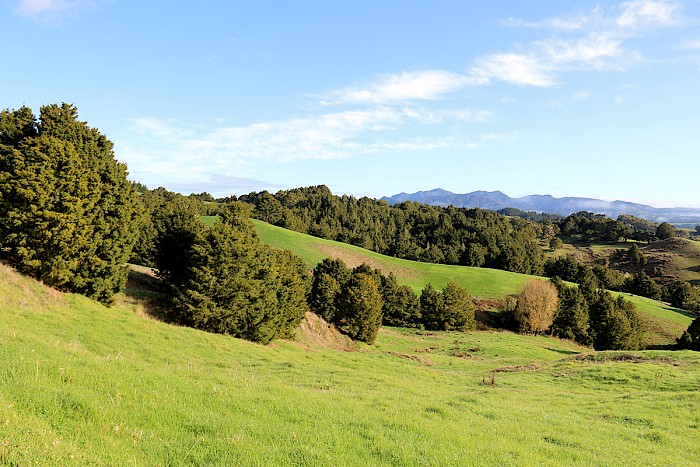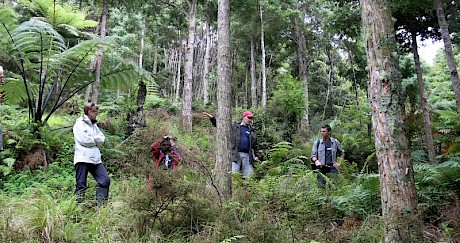Totara (Podocarpus totara)
 Distribution
Distribution
Totara (Podocarpus totara) is naturally distributed throughout New Zealand in lowland forests (Bergin 2003). It has been utilised for many purposes by both Maori and European settlers and with the largescale clearance of coastal and lowland forests there are only small quantities available from high forests for management as a timber resource. However, the clearance of the original high forest and establishment of pastoral farmland has seen prolific regeneration of totara as second-growth stands for over a century throughout New Zealand. This includes Northland, Auckland, Waikato, Bay of Plenty, King Country, inland Hawke’s Bay, Wairarapa, Horowhenua, Nelson and part of Blenhiem, Kaikoura, Westland and Southland (Bergin 2003). In Northland regenerating totara also occurs across large areas of multiply-owned Maori land.
Regeneration and development
Totara can be regarded as a hardy pioneer species where it readily establishes on open sites including amongst sparse weedy grass cover. It is more tolerant of dry soils and seasonal drought than other podocarps but is intolerant of poorly drained soils where kahikatea is often present. Where there is a seed source totara is typically found establishing on the less productive slopes in pastoral hill country, as well as along riparian areas where it provides shading that is crucial to water quality enhancement.
Totara produces seed every year which is widely disbursed by birds which results in establishment across farmed landscapes as either single large-crown trees, or in small groups and large dense stands where trees develop well-formed straight stems. In Northland and other regions, it is often regarded as a weed and relegated as only useful for firewood due to its propensity to readily regenerate and the perception that it develops into poor form trees as seen in the highly conspicuous single trees in paddocks or in edge trees of stands.
 Photo: H Janssen, Bush Vitality AssessmentHowever, there are many small and large dense stands of regenerating totara-dominant forest on pastoral farmland sometimes in mixture with other relatively unpalatable species such as manuka, kanuka and exotic brush weeds such as gorse. Over time mixed stands become dominated by totara as the shorter-lived species are shaded out. These dense regenerating stands of well-formed totara represent a significant existing and developing resource in our pastoral landscapes and scrubland. Its ability to establish in a paddock and compatibility with livestock farming means it has truly unique potential for widespread integration into our production landscapes including Northland.
Photo: H Janssen, Bush Vitality AssessmentHowever, there are many small and large dense stands of regenerating totara-dominant forest on pastoral farmland sometimes in mixture with other relatively unpalatable species such as manuka, kanuka and exotic brush weeds such as gorse. Over time mixed stands become dominated by totara as the shorter-lived species are shaded out. These dense regenerating stands of well-formed totara represent a significant existing and developing resource in our pastoral landscapes and scrubland. Its ability to establish in a paddock and compatibility with livestock farming means it has truly unique potential for widespread integration into our production landscapes including Northland.
Management for wood
Preliminary wood utilisation studies indicate the wood in relatively young, naturally regenerating totara on farms has many of the inherent wood quality properties found in trees logged from old-growth stands (Bergin 2003). However, before a supply and demand chain for sustainable farm-grown totara can be set up more information on the size of the existing resource is required.
There is increasing interest in actively managing these naturally regenerating stands for sustainable timber production. However there has been very little work carried out on what management is required to maximise the production from these stands. There is a need for demonstration areas of managed naturally regenerating stands of totara on farmland where different thinning, pruning and other silvicultural options can be tested to boost growth rates, improve tree form, and produce timber of high value for specialty uses. This has been the major focus for the Northland Totara Working Group for over a decade and continues in a range of current projects underway in Northland.
Planted totara
Totara has been the most widely planted native conifer in New Zealand with small plantations established from the early 1900s. Seedlings are easily raised in large numbers in nurseries and transplant well to a range of planting sites. There is a wide variation in growth rates due to differences in site type, management history and stocking rate. Growth modelling of a limited number of stands indicates that while growth is initially slow, it does accelerate during the pole phase with significantly higher volume growth compared to unmanaged dense naturally regenerated stands.
Planting is an option for extending totara where natural regeneration is not occurring including within the Northland region to complement second-growth stands. Further monitoring will enable the determination of growth rates and a comparison of the wood quality of planted versus regenerating totara.
Multiple benefits
Expected nationally important benefits include increased appreciation and retention of naturally regenerating stands of native forest on farmland for significant multiple benefits of sustainable production of timber, enhancing biodiversity and landscape values, improved erosion control and waterway management in our productive landscapes.
The aims of the NTWG to sustainably manage farm-grown totara clearly align with the recommendations of the Parliamentary Commissioner for the Environment (2002) that native plants become a vital and more widespread component of New Zealand’s working lands, i.e. in addition to biodiversity objectives, they will be widely valued and managed for their essential contribution to our wellbeing, cultural identity, sustainability of our land, and creation of wealth. It also meets the PCE’s call for innovation and even “re-design” of farming systems. In this respect, the natural attributes, distribution, management and potential role of totara makes this a most exciting choice for further exploration and research.
Northland Totara Working Group (NTWG)
There are a wide range of outputs from the work of the NTWG and TTT relating to research and management of naturally regenerating totara. These are available on the NTWG Publications & Resources page and also the NTWG Newsletters page.


